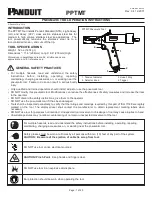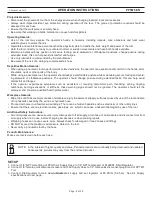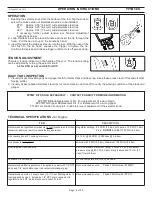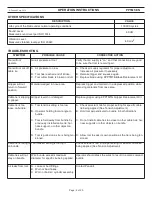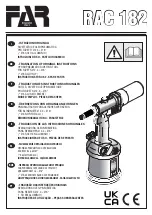
Page: 4 of 20
TROUBLESHOOTING
© Panduit Corp. 2015
OPERATION INSTRUCTIONS
PPTMT-EN
SYMPTOM
POSSIBLE CAUSE
CORRECTIVE ACTION
Tool will not
operate.
No air pressure at tool.
Verify that air supply is “on”, and that connections are good
to be sure that tool is receiving air.
Tool will not cut off
cable tie.
A. Air pressure too low.
B. Tool has reached end of stroke.
C. Tool cutter blade is broken or dull.
A. Check air supply regulator for proper adjustment.
Increase air pressure if necessary.
B. Release trigger and squeeze again.
C. Replace blade using KPPTMTB Blade Replacement Kit.
Gripper will not
return to forward
position.
Material wedged in nose area.
Depress trigger and maintain in a depressed position while
removing materials from nose area.
Cable tie is slipping
in gripper.
Gripper is worn or damaged.
Replace gripper using KPPTMTG Gripper Replacement Kit.
Cable tie is too
loose on bundle.
A. Tool tension setting is too low.
B. Operator holding tool at angle to
bundle.
C. Tool is held away from bundle by
previously installed cable tie, har-
ness support, or other object on
bundle.
D. Tool is pulled on as tie is being ten-
sioned.
A. Check selector knob for proper setting for specific cable
tie being applied (See Tension Adjustment).
B. Hold tool perpendicular to bundle in both directions.
C. Do not install cable ties too close to other cable ties, har-
ness supports or other objects on bundle.
D. Allow tool to seek its own position as the tie is being ten-
sioned.
Cable tie is too tight
on bundle.
Tool tension setting is too high.
Check selector knob for proper setting for specific cable tie
being applied (See Tension Adjustment).
Cable ties will not
stay on bundle.
Wire bundle exceeds maximum
diameter for specific tie being applied.
Operator should dress the wires to result in a more compact
bundle.
Air leaks from tool.
A. Loose or bad fittings.
B. Worn or bad hoses.
C. Worn or bad air cylinder assembly.
Contact Panduit
OTHER SPECIFICATIONS
DESCRIPTION
VALUE
Life cycle of the blade under normal operating conditions
100,000 cycles
Sound Level:
Measured sound level per ISO 15744
69 dB
Vibration Level:
Measured vibration level per ISO 20643
4.9 m/s
2


